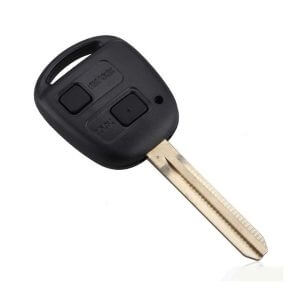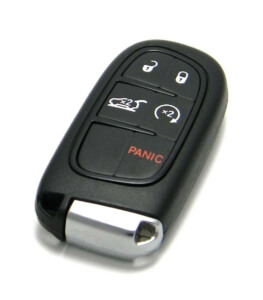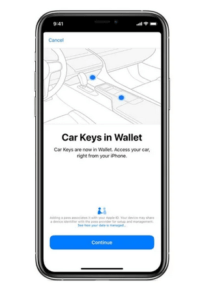Carlisle’s Perspective
Carlisle believes that smart keys (commonly known as key fobs) will be the dominant automotive car key product in the coming decades; however, virtual keys will grow simultaneously and displace the smart key market in the long run.
- Smart keys are the dominant automotive key in today’s market, coming as a standard option on 62% of model year 2018 cars. Carlisle predicts adoption to continue to increase in the coming years
- Over time, however, the technology will be rendered obsolete by the rise of virtual keys
- Virtual keys will come to dominate the market for two primary reasons:
- Increase in Functionality: The function of the smart key is limited to standard car operations. Virtual keys provide owners creative solutions to modern problems and the capability to integrate more features over time
- Vehicle Sharing and Key Replacement: Virtual keys have the potential to make key sharing simple by digitizing the process and make key replacement obsolete, since the key will be on the customer’s phone for the lifetime of their ownership of the vehicle
- That said, adoption of virtual keys will be slow due to:
- Cybersecurity Threats: OEMs are still designing systems that effectively protect against cybersecurity threats
- Customer Sentiment on Product: Customers do not fully trust virtual keys in terms of reliability and safety features, as theft protection is a significant concern and mobile phones are susceptible targets
- Virtual keys are currently a complementary product to smart keys – for eligible vehicles, customers can access their virtual key through their owners’ app and still have access to the key fob. Carlisle believes that this trend will continue until the above concerns are resolved, and then virtual keys can exist as a standalone product for consumer
Keys Overview
This section summarizes the evolution of automotive car keys in the United States over the last century and driving forces that have led to the adoption of new products
Traditional Keys
- The traditional key was first introduced to the automotive market in the mid-1900s [Source]

- To operate a car using this product, an owner inserts the key into the ignition to start the vehicle – this was the first version of the mechanical key
- The traditional key’s simple design made it easy to replicate, leading to high rates of theft. Consequently, customers sought out an alternative option that would provide an enhanced level of security
- Laser cut keys (aka internal keys) are a type of mechanical key that is more precise and offers higher security because of its complicated design – this key has a constant depth down the middle of the key
- These keys require special equipment and processes to create, making them more difficult (yet not impossible) to duplicate and their ignitions more difficult to penetrate
Transponder Keys
- OEMs then introduced the transponder key to the market in the late 20th century to further meet customer preferences for a secure device
- The transponder key has an internal RF transmitter that communicates with a receiver that is near the ignition of the vehicle – with this technology, the key is not able to turn the ignition unless the receiver in the vehicle receives a signal from the key handle [Source]. This added key element made it even more difficult to duplicate
- Adoption of transponder keys grew because customers felt more secure with the product, leading the traditional key (both the first and the laser version) to become obsolete
- Now, customers faced a new problem – key replacements
- With transponder keys, the effort required to properly replace keys increased due to the additional complexity of chip programming (Please see Key Programming and Sales Distribution Overview section for more information on the subject)
- Different customer channels also emerged, as both individual car owners and retail organizations (such as car auction houses) required different solutions for replacements (Please see Key Provider Overview section for more information on the subject)
- While transponder keys are more secure than traditional keys, the product eventually saw a decrease in market penetration with the emergence of more advanced technology
Smart Keys
- A smart key is a key fob that gives the operator access to lock, unlock, and start their vehicle while the key is in their pocket – smart keys are complementary to a “push-to-start” vehicle ignition

- Smart keys were first introduced to the market in 1998 by Mercedes-Benz, who offered their “Keyless-Go” product on the S-Class [Source]
- Brands advertised the product as an upgrade from transponder keys in terms of both owner convenience and security
- Vehicle owners began to prefer this technology over transponder keys, as the smart key offered a hands-free user-friendly experience
- Market penetration of this product has grown gradually over the years – in 2018, smart keys were standard on 62% of new cars, up from 11% in 2011 [Source]
- There are two underlying reasons for the growth of this technology
- Improved Customer Experience through Touchless Operations: Vehicle owners no longer need to shuffle through their belongings to unlock, lock, or operate their cars. This capability has led to widespread adoption and praise among users. Beneficial features include:
- Transmitter Technology (Remote Keyless Entry) [Source]: Transmitter technology, used in tandem with infrared sensors, pairs an owner’s key fob to the car’s internal engine control unit (ECU). This technology recognizes the paired key’s presence within range of the vehicle and executes specific operations if the correct signal is transmitted. Once the user is within 20 meters of the car, this technology automatically unlocks the car and locks it again when the fob is out of range. The operator can start the vehicle without inserting a key into the ignition, assuming the user is within a one-foot radius of the vehicle
- Capacitive Sensor Technology (Passive Keyless Entry) [Source]: Capacitive sensors are the technology integrated into the actual vehicle which locks, unlocks, and starts the car. The feature ensures that the vehicle is locked when leaving and prevents theft arising from events of owner neglect
- Enhanced Security Features: Smart keys build upon the security offered by transponder keys, improving protection by integrating the following technology [Source]:
- Rolling Code from Transmitter [Source]: Rolling code is a layer of additional security in transmitter technology. This system continually changes the frequencies that connect smart keys with vehicles to prevent theft. This feature is an evolutionary step past transponder keys because transponders have a fixed code that can be hacked and duplicated. A rolling code makes the process of hacking into the software of a vehicle much more difficult because the pattern is constantly changing
- Infrared Sensor Technology [Source]: Infrared sensors are electronic devices that detect signals emitted from a transmitter in a specific location. This technology allows the smart key to communicate with a vehicle within a particular range. This feature also enhances security, as the sensors allow transmitters to notify the car when the user approaches and leaves the car’s surrounding environment
- Smart keys have presented the market with an effective solution to consumer demands – penetration has increased over time:
- Tier 1 suppliers responsible for manufacturing these products have also seen significant success since adoption, including Alps, Calsonic Kansei, Continental, Denso, Hella, Lear, Panasonic, Valeo, and ZF [Source]
- The current threat to their future growth revolves around emerging technologies that seek to outperform smart keys, such as virtual keys and smart key cards – nevertheless, smart keys will dominate the market in the near future, given their penetration with existing UIO
- Improved Customer Experience through Touchless Operations: Vehicle owners no longer need to shuffle through their belongings to unlock, lock, or operate their cars. This capability has led to widespread adoption and praise among users. Beneficial features include:
Virtual Keys and Smart Keys
- Virtual keys entered the market in the 2010s, with Tesla becoming the first OEM to make the functionality standard for the Tesla Model 3 [Source]

- In Tesla’s model, the virtual key is not a standalone product – customers are also given a key card that allows them to lock and unlock their vehicle, supplementing the physical shortcomings of the virtual key (i.e. inability to share the key with another person)
- This key card is different from traditional smart keys for three significant reasons:
- Smart Key Design: Tesla’s smart key is currently designed as a key card, instead of the traditional fob, allowing users to access and operate the vehicle but providing less functionality than the traditional smart key fob
- Programming Needs: These smart keys can be programmed directly to the car, via WIFI, by the user, avoiding dealerships and other parties completely
- Key Card Price: If owners lose their key card, they can purchase a replacement on Tesla’s site for $25 and program the key themselves once the card arrives
- Virtual keys, on the other hand, are integrated into smartphones and other connected devices, allowing customers to access their cars using Bluetooth technology, and owners can then communicate with their vehicle through an app on their phone [Source]
- Like smart keys, virtual keys offer touchless operations and sophisticated security but go further by providing users additional functions and creative solutions to modern problems:
- Vehicle Status and Operational Data [Source]: Virtual keys show vehicle data to users, such as miles driven, fuel levels, and vehicle location
- Key Sharing Capabilities [Source]: While this feature is still in the process of deployment, many virtual keys promote the idea of users being able to share keys virtually, avoiding the inconvenient handoff of keys to friends or family who may need to access a vehicle. This feature is also significant for the expansion of carsharing companies, like Zipcar and Turo, as customers would be able to avoid additional steps to access a vehicle
- There are two hurdles to widespread, standardized adoption of virtual keys:
- Slow Technological Development and Cybersecurity Threats [Source]:
- Given the “hackability” of smart phones, there is a concern with allowing vehicles to be turned on and off using the near-field communications (NFC) that virtual keys and key cards rely on
- Certain OEMs in the United States have dedicated teams to developing features such as enhanced security and encrypted key sharing capabilities for virtual keys, but many are facing technological roadblocks to dependable, secure solutions
- Customer Sentiment on Product [Source]:
- Customers do not have complete trust in virtual keys in terms of reliability and safety features, as theft prevention is a significant concern and mobile phones are susceptible targets
- Since the technology behind virtual keys is still developing, adoption will likely be slow – but in the long run, virtual keys paired with a less expensive and more user-friendly smart key card will dominate the automotive key market, as their customer offering revolves around less expensive, flexible features that enhance user convenience
- Slow Technological Development and Cybersecurity Threats [Source]:
Summary
- Smart keys are in a strong position in today’s marketplace, but the technology will eventually become disrupted once broad acceptance and functionality of virtual keys increases
- In the near future, smart keys and virtual keys will be complementary to each other – owners will continue to receive smart key fobs with their vehicles but will increasingly also have the ability to use the virtual keys offered through their Owner Apps
- Once virtual keys gain broader adoption and develop customer confidence, they will completely dominate the automotive key market and displace today’s smart key, as seen with early adopters like the Tesla Model 3 [Source]
- More advanced technology, where a user accesses a vehicle through other multi-purpose information tools, are possible, but these solutions are predicted to occur in the far distant future
Smart Key Comparative Analysis
Smart Keys vs. Traditional and Transponder Keys
Strengths
- Adoption by both Luxury and Volume Brands: Growing adoption of smart keys by both luxury and volume brand OEMs for new vehicle models [Source, Source]
- A wide range of leading car manufacturers, ranging from BMW and Audi to Honda and Hyundai, have incorporated smart keys in newer model-year vehicles
- The primary reason for this adoption is the increased customer expectation of a digital first brand experience, as OEMs are now attempting to leverage all technology available to continue to attract potential customers to their brands
- As a result, the adoption of smart keys is expected to increase since the number of OEMs implementing this technology grows, and newer vehicle models are integrating the product in their systems
- Security: More robust and secure anti-theft features in smart keys compared to traditional and transponder keys [Source]
- The growing market penetration of smart keys has been due in large part to filling gaps in security that were prevalent in previous customer offerings
- Many customers feel secure with the technology in smart keys, and their trust in the product will likely lead to continuous growth in the market until even more trustworthy solutions are introduced
- Convenience: Improved ease of use accessing and operating vehicles compared to traditional and transponder keys [Source]
- Customers prefer smart keys due to the convenience of accessing and operating their vehicles, and once they become accustomed to the features, it is unlikely that they will revert to previous offerings
Weaknesses
- Previous Hacking Events: The credibility of smart keys have been questioned in the past as a result of security fraud and theft, leading some customers to lean toward more traditional technology like traditional or transponder keys [Source]
- A series of reports were published by the Swiss Federal Institute of Technology, which uncovered cases where smart keys became accessed through different hacking attempts
- Specifically, smart keys were most susceptible to RF attacks, as attackers duplicated the rolling code that devices transmitted to open and operate vehicles
- It is important to note that many OEMs have taken serious actions to enhance security measures to prevent future security defects
- Unless OEMs implement more advanced technology into smart keys, it seems there will always be a margin of susceptibility to these types of attacks
Opportunities
- Expanding Customer Base within Automotive Market: Smart keys are established products in today’s marketplace, which has led to a large customer base that is expected to grow in the future [Source]
- Smart keys have gained market share in the automotive key market gradually, with adoption growing from 11% in 2008 model year vehicles to 68% in 2019 model year cars
- Due to this broad adoption and high customer demand, we expect that more OEMs will implement this technology, and newer vehicle models will see increased integration of these products over traditional or transponder keys
- Expanding Customer Base outside Automotive Market: While outside industries do not currently adopt this technology, markets like heavy equipment and heavy truck could potentially be open to implementation in the future
- Security is a significant concern for expensive machinery, making the technological capabilities of smart keys potentially attractive to these markets
- While there is little data on current adoption in these industries, the application is extremely relevant, and suppliers could potentially make a seamless switch to integrate the technology into these vehicles
Smart Keys vs. Virtual Keys
Strengths
- Currently Adopted and Trusted Technology: Smart key customers trust the product’s security features more than emerging technology such as virtual keys [Source]
- The strength of smart keys in this scenario is the combination of the trust from the customer base in tandem with the uncertainty of risks presented by virtual keys
- OEMs are still trying to solve technological issues with beta versions of virtual keys since the product is vulnerable to cyberattacks such as [Source, Source]:
- Rogue Access Point (AP) for WIFI Communications: A rogue AP attempts to access owner information by connecting a phone or vehicle to a false WIFI server that appears secure. These WIFI servers are deceptive, as they are designed to appear safe. Users mistakenly connect to these servers and grant hackers an avenue to access their personal information. Since personal and financial information is tied to a vehicle’s virtual key, users may be hesitant to adopt this technology due to the possibility of risking the security of their data
- Manipulating the ECU (Engine Control Unit) information: Keyless communication systems, such as Transmitter Technology (Remote Keyless Entry) and Capacitive Sensor Technology (Passive Keyless Entry), function by connecting to a vehicle’s ECU. Virtual keys are susceptible to these attacks, as they typically connect to multiple sources such as the internet and Bluetooth. Attackers install harmful code on an individual’s phone, which grants a separate user access to the vehicle’s ECU. Successful attacks can give hackers the ability to unlock or operate a car, as well as extract information from the vehicle’s ECU
- Bluetooth Attacks: Hackers perform this type of attack by accessing a user’s device via a Bluetooth connection to extract personal or financial information. Similar to a rouge AP attack, hackers will establish a seemingly safe Bluetooth signal. If the vehicle owner connects to this signal, the attacker can connect with their device to access their data. This type of threat does not apply to smart keys, as this type of personal information is not stored on the device. For virtual keys, accessing this type of information is a severe risk and significant consideration when considering shifting to the tool
- Use of Malicious Applications: Malicious applications are software that users may accidentally download to their mobile device, which grants outside users access to their data. Attackers typically disguise these programs as being safe for installation. Personal information, such as financial accounts stored through virtual keys, may be at risk after downloading the corrupt software
- Radio Frequency (RF) Attacks: RF attacks occur when hackers gain access to the rolling code that connects a virtual key, or even smart key, to a vehicle. If hackers are successful, they can gain access and operational functionality of a vehicle
- As a result of these threats to virtual keys and the trust already established with existing product offerings, smart keys are in a strong position in today’s market
Weaknesses
- Technological Limitations: There are limits to smart key functionality, making the product susceptible to the rise of virtual keys as they offer more customization and features [Source]
- Smart keys are limited in the features they can provide customers, and the technology is unable to match offerings that are possible through virtual keys
Opportunities
- Slow Emergence of Virtual Key Technology: OEMs have been slow to offer virtual keys in vehicles due to the technical complexity required, which slows their growth in the immediate future [Source]
- Due to the complex technology incorporated in virtual keys, it is unlikely that many OEMs will immediately change to the newer offerings simply because the capability exists
- As a result, users will likely continue to rely on smart key fobs for operational applications but lean on virtual keys for core insights on their vehicle’s data and status
Threats
- Future Security Threats: Future hacking events could lead to customers losing confidence and opting for different products such as virtual keys [Source]
- OEMs need to prioritize increasing the security features of smart keys, as hacking events were headline news when adoption was growing significantly in 2016
- If hacking events were to resurface, customers might opt for different key options
- Ease of Replacements: The cost of replacing a smart key is high, and virtual keys eliminate the need for replacing keys since they can be accessed online [Source]
- Currently, the fee to replace a smart key is large, ranging between $250 – $600 per key
- Virtual keys offer a solution to this expensive replacement, as users can access a virtual key through their mobile devices and technically never lose their keys
- The paired key cards, in Tesla’s case, are less expensive to purchase and do not require interaction with other parties for programming
- As a result, the virtual key threatens the smart key replacement market, as individuals who lose their keys may opt for virtual keys or key cards instead of paying the fee for a replacement set of smart keys
Key Programming & Sales Distribution Overview
Programming
- “Key programming” is the act of connecting the transmitter in a smart key to a VIN – doing this correctly is critical to ensure proper security and operational functionality of the key [Source]
- It is important to understand that the key programming market is only relevant for replacement keys, as dealerships provide owners a set of keys for their car at the point of sale, and therefore users do not need to pursue one of the various distribution channels to purchase a set
Distribution Channels
- Within the key replacement market there are two main customer channels, who typically utilize specific providers:
- Typical Customer Channel [Source]: Vehicle owners who need a replacement key for their existing vehicle typically use the following providers:
- 3rd Party Online Services [Source]: Online sites that allow customers to order and program keys virtually (these providers are more commonly referred to as factory parts resellers)
- Registered Locksmiths [Source]: Professionals who specialize in automotive key replacements
- Vehicle Breakdown Services [Source]: Services such as AAA or similar companies
- Dealerships [Source]: Typical OEM dealerships
- IRFs [Source]: Independent repair facilities or “Mom and Pop Shops”
- Car Auction Channel [Source]: Organizations purchasing keys in large quantities for vehicles to auction primarily work with 3rd party online services or registered locksmiths
- Typical Customer Channel [Source]: Vehicle owners who need a replacement key for their existing vehicle typically use the following providers:
Key Provider Overview
3rd Party Online Services [Source; Source]
- These service providers offer both individual vehicle owners and vehicle auction houses the lowest cost keys on the market at a higher level of service
- The stores function through online websites, with popular providers being organizations such as Car Keys Express and Replace My Remote
- Providers offer options to purchase keys for a large number of vehicle models, which can be programmed at their facilities and shipped to customers
- Sites also offer more exclusive services to auction houses in an attempt to gain strategic partnerships and a higher volume of business – these offers include [Source]:
- Mobile Service: Sites will send mobile service vans to auction houses to program multiple keys for different vehicles during a single visit
- In-House Replacements: Online sites will ship cut keys to auction houses, advertising superior pricing, selection, and technical support after shipment
- Buy-back Programs: These online providers also seek to refurbish used or damaged keys and will also pay cash for auction houses looking to sell keys
- Through this dual-channel strategy, many 3rd party online services see profit margins ranging from about 50% to 70% [Source]
Registered Lock Smith [Source]
- Registered locksmiths are professionals who specialize in programming replacement keys for both customers and vehicle auction houses
- These providers are generally the preferred avenue after 3rd party online services due to having lower costs than alternative options
- These businesses have the tools and skillset to program an individual’s key to their vehicle accurately
- Providers typically have express services dedicated to programming keys that dealerships may lack and provide an enhanced level of service to customers
- These businesses typically charge more than online 3rd party online services but less than dealerships, realizing a profit margin of about 100% [Source]
Vehicle Breakdown Service [Source]
- Roadside assistance providers are companies, such as AAA, that primarily assist individuals with breakdown issues but can also provide services like replacing lost keys
- Sources note that these channels typically have a lower level of service and higher price than the options mentioned above
- No public information is available about the profit margins these companies create as a result of key replacement services
Car Dealership [Source]
- Car dealerships are the primary solution for servicing vehicles; however, many customers seek alternative options for key replacement due to low service and high rates
- Dealerships typically charge a higher price for key replacements than any other provider in the market, generally creating a 300% profit margin [Source]
- As a result, customers flock to less expensive providers that offer a higher level of service
Independent Repair Facility (IRF) [Source]
- IRFs, more commonly referred to as Mom and Pop Shops, operate in the key replacement market as an additional service to typical vehicle maintenance
- The offering of IRFs varies due to the technology they have available and if it is applicable for coding the key for an individual’s specific vehicle
- Service and price are comparable to dealerships; however, we expect margins are smaller due to less purchasing power from these providers
Authors

Saurabh Mahajan
Manager

Ryan Monahan
Associate Consultant